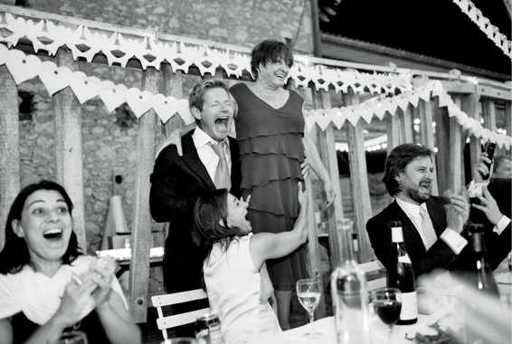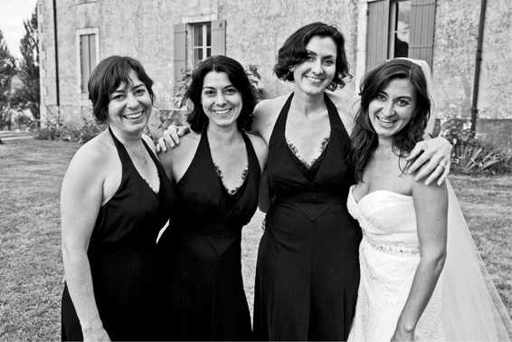It's What I Do: A Photographer's Life of Love and War (33 page)
Read It's What I Do: A Photographer's Life of Love and War Online
Authors: Lynsey Addario


The day before I left the hospital, the Turkish ambassador arrived at my bedside with a posse of diplomats and offered Paul and me a place to stay in the Turkish Embassy in Islamabad once I was released. The nurses continued watching the flurry of activity in and out of my room with curiosity. Almost immediately after the ambassador left, another set of visitors arrived: Haleem, my sympathetic-to-the-Taliban interpreter from the “Talibanistan” story the year before, along with one of his cousins. I was mortified that my hair was uncovered and I was wearing a hospital gown with skin exposed in front of two deeply religious men. Each visitor had a very long beard and wore an ankle-length kurta, a loose-fitting collarless shirt. Haleem toted a bag of hand-picked oranges, and Paul invited him and his cousin to sit down.
I thanked them for coming. “How are you, Haleem?” I asked.
“Well. We are fine,” he said, “though my cousin’s house was hit by a drone yesterday . . .”
Life in Pakistan went on.
• • •
A
FEW DAYS LATER
Paul and I flew back to Istanbul, and on May 19, 2009, I had a titanium plate put in my shoulder. I was completely unprepared for the post-op misery. I only wanted to be healthy again, to be able to walk down the aisle at our wedding in six weeks.
Night after night I woke up screaming and weeping with daggerlike pains shooting through my shoulder and chest. For the first time in my life I was injured; I could not take care of myself, and I realized how long I had taken my independence for granted. The simplest tasks became impossible without the use of my left shoulder and arm: I couldn’t bathe, I couldn’t put on my own bra, and I couldn’t fully dress myself. In the weeks leading up to our wedding, Paul spent every morning before work walking me to the shower, washing my body, toweling me off, putting on my underwear, clasping my bra, dressing me, and preparing whatever I needed for the day while he was off at work. I knew that seeing me so fragile and vulnerable was taking a toll on him emotionally, wearing him down. He was taking care of me, running a hectic news bureau, and planning our entire wedding—alone. I had never relied on someone so completely before, and I felt guilty for being so helpless. Paul’s determination to nurse me back to health was humbling.
Only once did he allow his own suffering to show. He was sitting at the desk in our living room, looking at his laptop, and suddenly he started to cry. He had received an e-mail from Bill Keller, the executive editor of the
New York Times
, who wrote to say how relieved he was that I was OK. Keller’s simple words broke something in Paul. I could hardly bear to see it.
I spent the end of May and the beginning of June lying on my back, sleeping, or watching the cargo ships float along the Bosporus outside my window until Paul came home from work. My attention span wasn’t focused enough to help him with our wedding planning, to read a book, or to watch a movie. I tried working at my computer, but the pain was often so excruciating that I couldn’t sit up. I couldn’t work or go on assignment, and I couldn’t earn money. It was the first time I couldn’t rely on determination, physical endurance—or myself—to do anything.
Some weeks later I was well enough to have lunch with my Istanbul friends Jason and Suzy. Jason looked concerned. “When are you going to just stop all this war zone stuff?” he finally said. “Why not get pregnant?”
It was a valid question but a deeply private and anxiety-inducing one. I didn’t want to discuss it over lunch with friends when I was still physically and emotionally fragile. The suggestion that my work had become too dangerous, or that somehow getting pregnant was an adequate replacement for photography, struck chords deep down in me about my work, my life, and how I chose to balance the two—especially as I approached my wedding date. The car accident in Pakistan was just one more example of me walking away from a near-death incident relatively unscathed, and each time I survived I knew my luck wouldn’t last forever. Paul, like my parents and sisters, never asked me to stop working; he never asked me to tone down my life or shy away from risk. He knew better than to ask me to change, or to compromise what I believed in. But every traumatic incident inspired inner dialogue that I wasn’t necessarily ready to confront, and in this case it was especially easy to chalk the accident up to chance: It was just a car accident! That could happen anywhere! I talked things through with Paul, updated my will, and moved forward.
But I got angry when my friends challenged a resolve that was already often painful to maintain. As I moved out of my twenties and into my thirties, my friends’ advice evolved from “stop running around war zones” to “stop running around war zones
and get pregnant
.” It was even more infuriating. In my early twenties my response was simple: “I don’t have a man. And I prefer to be doing exactly what I am doing.” Since Paul and I had gotten engaged, however, he had talked repeatedly about his desire for a family. I knew I wanted a family
eventually
, but I was finally at the height of my career, shooting all the assignments I had dreamed of shooting, for some of the best publications in the world. The last thing I wanted was to interrupt that momentum for a baby that I wasn’t yearning for at that point in my life. Unlike many of my female friends in their midthirties, I was definitely not sensing my biological clock ticking; in fact, I often wondered if I had been born without one.
And I couldn’t just have a baby and go back to Afghanistan. If I took a month off, I was likely to be replaced by one of the other, say, two hundred freelancers vying to get my assignments. If I took six months off to have a baby, I believed I would be written off by my editors. I was in a man’s profession. I couldn’t think of a single female photojournalist who was married or had a child. If Jason didn’t think I struggled with all this, he was wrong.
• • •
O
UR WEDDING TOOK PLACE
at Paul’s father’s home in southwest France: a stone castle in the midst of rolling cornfields, off a narrow country road lined with English plane trees that made of it a green tunnel, specks of sunlight bursting through the leaves. I thought of the opening passage of James Salter’s
A Sport and a Pastime
, even though he was referring to life in a city, every time we sped along the road from the stone house toward medieval Lectoure, the nearest town.
September. It seems these luminous days will never end. The city, which was almost empty during August, now is filling up again. It is being replenished. The restaurants are all reopening, the shops. People are coming back from the country, the sea, from trips on roads all jammed with cars. The station is very crowded. There are children, dogs, families with old pieces of luggage bound by straps. I make my way among them. It’s like being in a tunnel. Finally I emerge onto the brilliance of the
quai
, beneath a roof of glass panels which seems to magnify the light.
Our actual wedding day began with a massive hangover from the pink-champagne party the night before. Paul and I had planned on respecting the tradition that bride and groom shouldn’t see each other the day of the wedding, but we were so hungover, we didn’t wake up until around 11 a.m., just hours before we were due at the church. During the Catholic ceremony Paul almost gave the elderly priest a heart attack when he said, “I, Paul de Bendern, take you, Lisa, to be my wife.” Lisa was my sister.

My family, meanwhile, had reunited happily. Paul and I loved spending time with Bruce and my father, who were still together. They had made up with my mom; we even all went on vacation together sometimes. It was a testament to my mother’s warm and forgiving nature and to my father and Bruce’s effort to bring us all together again. At my wedding dinner my mother stood up on a chair, her arms around Bruce, and said how excited she was that her daughter was marrying into royalty—“but I thought I’d introduce you all to a real queen!” And with that she thrust the flamboyant Bruce forward. The party roared with laughter. Nothing made me happier than watching my mother and Bruce, the original best friends, stand on a chair side by side and make a toast together as my father looked on. I wrapped my arms around her ankles and gazed up at her with admiration.

That day I looked around at all the guests—the collection of friends and family who had gathered from as far away as Peru, New York, Hong Kong, and California—then back at Paul, who was beside me, holding my hand. After all the years of hard work, unsuccessfully searching for love, the kidnapping in Fallujah, the ambush in the Korengal Valley, the car accident in Pakistan, I was so grateful to be sitting in the middle of the rolling hills of France with my family and closest friends, happy, drinking, and celebrating life.

• • •
A
FTER THE WEDDING,
I was finally able to go back to work. I was in a transitional phase in my photography, trying to edge out of daily news stories and focus almost entirely on more time-consuming magazine features and projects. In mid-September, three months after the wedding, I sat at my desk having an unsettling conversation with an editor from
National Geographic
. Sometimes the long lead times between the start and finish of a story for
National Geographic
made me question the impact of the work I was doing for them. Eighteen months passed between when I began a story and when I saw it in print. After years of photographing for the
Times,
I had grown used to the immediate gratification of working on stories and seeing them published within days or, at most, weeks. I had to convince myself that the stories I was photographing could have as much relevance published long after I shot the photos as those published the day after I shot them.
The editor and I had been talking about an assignment I had just begun shooting.
“Don’t shoot this story like a
New York Times
story,” he advised, in a slightly patronizing way. “Take your time with this story, get into it. Use the time you have to explore.”
He was right: I had spent so many years working on stories on deadline that I had to retrain myself to shoot with time and patience. I understood where the editor was coming from but was annoyed with the conversation, which left me feeling that he didn’t have faith in my vision as a photographer.
